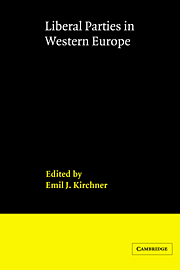Book contents
- Frontmatter
- Contents
- List of tables
- List of diagrams
- List of maps
- Notes on the contributors
- Preface
- 1 Introduction
- 2 Between left and right: the ambivalence of European liberalism
- 3 Two roads of Italian liberalism: the Partito Repubblicano Italiano (PRI) and the Partito Liberale Italiano (PLI)
- 4 The FDP in the Federal Republic of Germany: the requirements of survival and success
- 5 Great Britain — social liberalism reborn?
- 6 Liberalism in France
- 7 Liberal parties in the Netherlands
- 8 The Belgian liberal parties: economic radicals and social conservatives
- 9 The Freiheitliche Partei Österreichs: protest party or governing party?
- 10 The Swedish Liberal Party: The politics of unholy alliances
- 11 Liberalism in Denmark: agrarian, radical and still influential
- 12 The Norwegian Liberal Party: from political pioneer to political footnote
- 13 Liberal parties in Finland: from perennial coalition actors to an extra-parliamentary role
- 14 Liberal parties in Switzerland
- 15 The Luxemburg Liberal Party
- 16 Identifying liberal parties
- 17 Ambivalence revisited: an analysis of liberal party manifestos since 1945
- 18 Transnational links: the ELD and Liberal Party Group in the European Parliament
- 19 Western European liberal parties: developments since 1945 and prospects for the future
- Index of political parties
- General index
8 - The Belgian liberal parties: economic radicals and social conservatives
Published online by Cambridge University Press: 16 November 2009
- Frontmatter
- Contents
- List of tables
- List of diagrams
- List of maps
- Notes on the contributors
- Preface
- 1 Introduction
- 2 Between left and right: the ambivalence of European liberalism
- 3 Two roads of Italian liberalism: the Partito Repubblicano Italiano (PRI) and the Partito Liberale Italiano (PLI)
- 4 The FDP in the Federal Republic of Germany: the requirements of survival and success
- 5 Great Britain — social liberalism reborn?
- 6 Liberalism in France
- 7 Liberal parties in the Netherlands
- 8 The Belgian liberal parties: economic radicals and social conservatives
- 9 The Freiheitliche Partei Österreichs: protest party or governing party?
- 10 The Swedish Liberal Party: The politics of unholy alliances
- 11 Liberalism in Denmark: agrarian, radical and still influential
- 12 The Norwegian Liberal Party: from political pioneer to political footnote
- 13 Liberal parties in Finland: from perennial coalition actors to an extra-parliamentary role
- 14 Liberal parties in Switzerland
- 15 The Luxemburg Liberal Party
- 16 Identifying liberal parties
- 17 Ambivalence revisited: an analysis of liberal party manifestos since 1945
- 18 Transnational links: the ELD and Liberal Party Group in the European Parliament
- 19 Western European liberal parties: developments since 1945 and prospects for the future
- Index of political parties
- General index
Summary
historical background
During the 1820s, an alliance between Catholics and Liberals had successfully brought about the independence of Belgium from the Netherlands. This Catholic–Liberal alliance – or unionism as it came to be known – continued until 1840 given the need for national unity whilst the Netherlands refused to accept the legitimacy of Belgium's separate existence.
Unionism was characterised by the formation of bipartisan Catholic–Liberal coalition governments regardless of parliamentary strengths. The latent church–state conflict was kept off the political agenda and the main political battles were not between clericals and anti–clericals but between conservatives and progressives over issues such as the extension of the electoral franchise. The difference between the conservatives and the progressives was, as Kossmann points out, one of temperament rather than doctrine or social origin (see Kossmann (1978) 167).
Unionism effectively ended in 1839 with the recognition by the Dutch of Belgian independence, a move which led to greater and more open hostility between Catholics and Liberals. The Liberals, in particular, were the aggressors, feeling that too many concessions had been made to the Catholics in order to gain the support of the Roman church in the struggle for national independence. Although the Liberals were not anti-religious, (indeed, many were practising Catholics), the party demanded a clearer separation between church and state as well as a recognition that the church was subordinate to the state in all temporal matters. For many Liberals, the main bone of contention surrounded the Catholic church's monopoly control of primary education and its attempt to gain a similar position within the sphere of secondary education.
- Type
- Chapter
- Information
- Liberal Parties in Western Europe , pp. 178 - 212Publisher: Cambridge University PressPrint publication year: 1988
- 1
- Cited by



